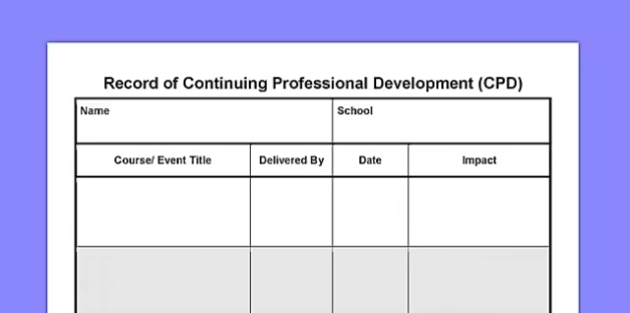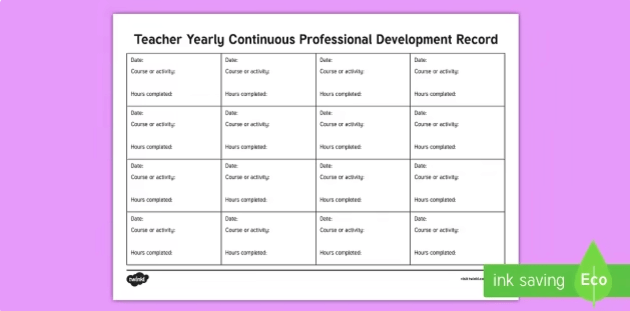Continuing Professional Development
CPD
If you're wondering 'what does CPD stand for in teaching?', we can tell you that CPD stands for Continuing Professional Development. This is typically implemented in school in the forms of training courses, inset days or staff meetings. CPD teaching programmes allow teachers (and other teaching staff) to stay up-to-date with their specialism and develop professionally.
CPD training allows staff to think more deeply about issues that might come up in the classroom and how they can be resolved. For some teacher CPD examples, you might carry out a training session on the safeguarding measures in place at your school, so that all staff members know how to deal with such situations should they arise. CPD training might also focus on how teaching staff can support children with additional needs.
Anything that improves your knowledge and skills in teaching can be considered CPD; however, there are two main types of CPD that are recognised, which are formal and informal.
Formal CPD might include taking a course or attending training or workshops. Informal CPD is less structured and might simply be listening to a podcast or reading a news article.
The CPD teaching profile
Now we've given a simple explanation of what CPD is in teaching, let's explore beyond the basic CPD meaning to look at what a CPD profile is.
Teachers, especially those in primary and secondary, should have a CPD profile for the current year and sometimes, the two years prior. A CPD teaching profile should have:
- A CPD plan, which includes development objectives and activities that fit in with their career goals, school priorities and any agreement reached during their annual professional review.
- A CPD record, which includes the CPD activities, training, seminars, etc., that the teacher has attended. This may also include your opinions and comments regarding said activities.
Why is CPD in education important?
If you're wondering 'why is CPD important in teaching?', you might be interested in learning more about the impact of CPD on teaching and learning.
According to the DfE's Standard for Teacher's Professional Development, "effective professional development for teachers is a core part of securing effective teaching".
In other words, CPD is indispensable and rightly so, as it offers one of the most effective ways to:
- develop a culture of improvement and excellence within the school;
- increase staff retention by gifting them with the chance to progress in their career;
- promote work satisfaction and workplace wellbeing;
- and, improve student performance with improved teaching skills.
In fact, this last point is the key to understanding the importance of CPD in teaching. Improved teaching skills bring about improved student performance, highlighting one of the most important benefits of CPD in teaching.
Why do you need CPD to improve teaching skills?
Teaching methods and skills aren't static; they evolve and adapt based on what's going on in the world.
For example, before the 1980s, computers weren't used in schools, so teaching skills didn't need to incorporate electronic devices. Now, though, these are ubiquitous and some schools rely on apps that can only be used with tablets to teach certain things.
Nowadays, teachers need to know how to use laptops, iPads, other tablets and mobile phones in the classroom setting. If you've never used these devices, you might need some training, which will count as part of your CPD.
That's the beauty of CPD; it allows teachers to learn new techniques or strategies to help them better impart knowledge and nurture a child's learning experience.
In other words, it doesn't restrict teachers to merely learning about what they need to teach (i.e., updates within the established curriculum). Instead, CPD addresses all development needs to maximise teachers' strengths to meet any challenges they may face in a changing world.
The following are a few examples of what CPD in teaching offers:
- improved interaction skills to better relate with students, peers and authority figures;
- increased motivation;
- greater ability for self-awareness, self-reflection and self-confidence;
- stronger commitment to teaching and its goals;
- new skills and how to apply them in the classroom for a more stimulating learning environment.
As you can see, you need teaching CPD to ensure all school staff have the right knowledge and skills required to support students and help them with their day-to-day roles. Dedicating time to CPD is vital to ensure every staff member can learn and grow within their role. It's also an excellent opportunity to open up your staff to new ideas, while reflecting on current practices and focusing on enhancing them to achieve the best possible results.
Examples of CPD in teaching
Unlike before, CPD now comes in many forms. You could join a more traditional school training day, where you and your colleagues physically attend a course. Or, you could do some CPD training online in the comfort of your own home.
Teachers need to be at the forefront of any big societal changes. After all, they are tasked with imparting the next generation with the knowledge they need to succeed, both for themselves and their respective societies.
That's why the Association of Teachers and Lecturers (ATL) section of the UK National Education Union states that CPD can take many forms. Teaching CPD examples include:
- training courses and workshops, which could be delivered on-site or online;
- studying for a qualification or accreditation, such as a Master's Degree in a specialist field (e.g. special needs);
- mentoring new colleagues;
- peer review and observation with other teaching staff in your school;
- reading relevant journals, articles or books about your specialism;
- watching documentaries about teaching;
- online courses/webinars/podcasts that don't need to lead to a degree;
- classroom observation, mentoring and peer-to-peer shadowing, where less experienced teachers learn from more experienced ones;
- attending exhibitions and conferences specifically designed so that teachers can learn from experts (e.g., researchers);
- international exchanges where a teacher goes to another country, usually to learn something groundbreaking that could also translate to improved results domestically;
- peer group exchanges, where teachers engage in constructive dialogue with other teachers;
- inner work, self-reflection, personal reading or research that can broaden a teacher's awareness and appreciation of specific or general aspects of teaching.
Because any number of the above experiences can dramatically alter or improve a teacher's development, goals and professional trajectory, CPD, by its very nature, is inclusive. It's rather like an umbrella, covering many experiences to attain the goal of continued professional development for teachers. Is it any wonder that UK schools spend £900M per year on education technology alone?
Features of effective CPD: what makes effective CPD for teachers?
While different experiences can fall under the CPD umbrella, they all need to have the following things in common to be effective.
CPD must be enjoyable
Learning is always better when it's fun. This is as true for children as it is for adults. That's why effective CPD needs to be something that teachers will enjoy doing. If it's boring or, worse, irrelevant, then teachers will come away feeling more stressed than before they started.
CPD must be practical
Teaching is a very hands-on experience and it happens in real-time. A classroom is not the place for quiet, contemplative research (unless you're a child doing chemical experiments in a lab). Teachers need skills that they can use ASAP, so any CPD they do must be practical.
CPD must be affordable
With budgets being cut left, right and centre, it's vital that CPD is as affordable as possible. Of course, just because something is cheap doesn't mean it's cost-effective, and something expensive doesn't automatically mean it's a waste.
If a £10 training isn't immediately useful or relevant to a teacher, it's still £10 wasted. But a £100 conference full of tips and resources that a teacher can use as soon as they step out of the conference room and back into a classroom is money well spent.
CPD must be evidence-based
CPD must also be based on current research to be effective. It can't be classed as an improvement if whatever's being taught constitutes a regression. In short, CPD must be evidence-based, proven by science and current.
CPD must be personalised
For CPD to be effective, it must also adapt to the teacher's needs. A primary teacher, for example, will have a vastly different skill set from a secondary teacher who specialises in children with learning difficulties.
CPD must be relevant
If you're teaching secondary students, you need to do CPD training designed for secondary student teachers. Undergoing training for primary teachers will not be relevant to you (unless you plan to switch from secondary to primary). Effective CPD must be relevant to you and your students.
CPD must be used consistently
CPD is only valuable if it's actually applied. If you learn something and then never use it again, it would've been a waste of your time and money. So, record and review each activity you've done.
Think about how you'd use the activity in the classroom to make a positive impact on both your students and peers. Then, incorporate whatever you've learned until it becomes a habit.
CPD must be supported
For a teacher to be able to implement changes in the way they teach, they may need approval from upper management or other professional bodies. Without support, it may be very difficult to effectively apply anything learned from CPD.
CPD must be collaborative
If a teacher is saying one thing and their peer is saying another, it could prove to be confusing for the community they serve. Teachers need to be seen as working together with their peers. Effective CPD is a collaborative effort.



